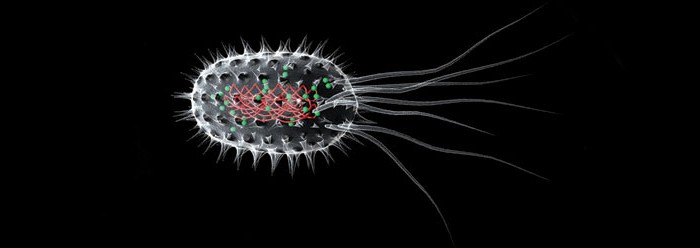A haploid cell is one in the nucleus of which contains a single set of chromosomes. These are mainly gametes - that is, cells intended for reproduction. Also, most prokaryotic organisms possess a haploid set of chromosomes. Somatic cells of eukaryotes (all except the reproductive) are diploid, in plants they can be polyploid.
The structure of prokaryotic cells
Prokaryotes are single-cell organisms in which there is no nucleus. These include only bacteria. Most of them have a single set of chromosomes.

The structure of their cell differs from eukaryotic in that it lacks some organoids. For example, they do not have mitochondria, lysosomes, Golgi complex, vacuoles, endoplasmic reticulum. However, like a eukaryotic, the haploid cell of prokaryotes has a plasma membrane consisting of proteins and phospholipids; ribosomes that are involved in protein production; cell wall, which in most cases is built from murein. Also, in the structure of such a cell, a capsule may be present, which includes substances such as proteins and glucose. Their chromosomes float freely in the cytoplasm, are not protected by the nucleus or any other structure. Most often, the hereditary material of bacteria is represented by only one chromosome, on which information about proteins that must be produced by the cell is recorded. The method of reproduction of such organisms is the simple division of haploid cells. This allows them to significantly increase their numbers in the shortest possible time.
Eukaryotic cells with a single set of chromosomes
In such organisms, the haploid nuclei contain cells called gametes. They can be very different from somatic. Reproduction by haploid cells is sexual, and a new organism can begin to develop only by the fusion of two gametes synthesized by different individuals of the same species.
The cell formed during the fusion of two haploid cells is called a zygote; it already has a double set of chromosomes. Despite the fact that germ cells are different from somatic diploid cells, they can still have some organoids inherent in eukaryotes.
Gametes animals
The germ cells of organisms belonging to this kingdom are called sperm and egg cells. The former are produced in the body of the male, the latter are females. Eggs are produced in the ovaries, and sperm in the testes. Both are specialized haploid cells that have various functions.
Egg structure
Female reproductive cells are much larger than male ones. They are motionless. Their main task is to provide the zygote for the first time with the nutrients necessary for division. The egg cell consists of the cytoplasm, membrane, gelatinous membrane, polar body and nucleus, in which there are chromosomes that carry hereditary information. Also in its structure there are cortical granules, which contain enzymes that prevent other sperm from entering the cell after fertilization, otherwise a polyploid zygote (with a triple or more set of chromosomes) could form, which would entail various kinds of mutations.
A bird's egg can also be considered an egg, but it contains much more nutrients so that they are enough for the full development of the embryo. The female reproductive cell of mammals does not contain as many organic chemical compounds, since at the later stages of the development of the embryo through the placenta, it receives everything necessary from the mother's body.
In the case of birds, this does not happen, so the entire supply of nutrients must initially be present in the egg. The egg also has a more complex structure. On top of the yolk sac and the protein membrane, it is covered with a shell, which plays a protective function, and there is also an air chamber in the structure, which is necessary to provide the nucleus with oxygen.
Sperm structure
It is also a haploid cell designed for reproduction. Its main function is the preservation and transfer of paternal inheritance material. This haploid cell is mobile, has a much smaller size than an egg, due to the fact that it does not contain nutrients.
The sperm consists of several main parts: the tail, head and the intermediate section between them. The tail (flagellum) consists of microtubules - structures built from proteins. Thanks to him, the sperm can move to its goal - the egg, which he must fertilize.
The intermediate section between the head and tail contains mitochondria, which are arranged in a spiral around the middle part of the flagellum, and a pair of centrioles lying perpendicular to each other.
The first are organelles that produce the energy that is needed to move the gamete. In the sperm head is a nucleus that has a haploid set of chromosomes (23 in humans). An autosome is located on the outside of this part of the male reproductive cell. In fact, this is a slightly modified, enlarged lysosome. It contains enzymes that are necessary for the sperm to dissolve part of the outer shells of the egg and fertilize it. After the male reproductive cell merges with the female, a zygote is formed, which has a diploid set of chromosomes (46 in humans). It is already capable of sharing, and an embryo is formed from it.
Haploid plant cells
The organisms of this "kingdom" produce similar germ cells. Females are also called ova, and males are called sperm. The first are in the pistil, and the second - on the stamens, in pollen. When it hits the pestle, fertilization occurs, and then a fetus is formed with seeds inside.
In lower plants (spore) - mosses, ferns - there is an alternation of generations. One of them reproduces asexually (by spores), and the other sexually. The first is called sporophyte, and the second - gametophyte. In ferns, sporophyte is represented by a plant with large leaves, and gametophyte is represented by a small green structure in the shape of a heart, and germ cells are formed on it.